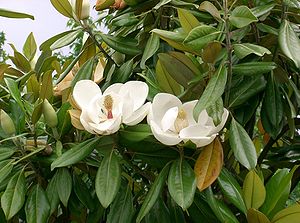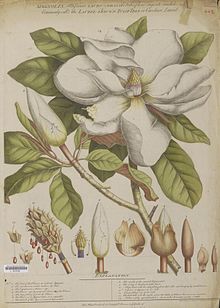Evergreen magnolia
| Evergreen magnolia | ||||||||||||
|---|---|---|---|---|---|---|---|---|---|---|---|---|

Evergreen Magnolia ( Magnolia grandiflora ) |
||||||||||||
| Systematics | ||||||||||||
|
||||||||||||
| Scientific name | ||||||||||||
| Magnolia grandiflora | ||||||||||||
| L. |
The magnolia ( Magnolia grandiflora ) is a plant from the genus of Magnolia ( Magnolia ) within the family of the Magnoliaceae (Magnoliaceae). It grows as an evergreen tree in the southeast of North America, where it is often cultivated as an ornamental wood and is considered a character plant of the southern states . There it is called "southern magnolia" or simply "magnolia".
description
Appearance and leaf
The evergreen magnolia is an evergreen tree and reaches heights of about 25 meters, in exceptional cases over 35 meters. The bark of young twigs and the buds are densely hairy, older twigs, on the other hand, have a bare, thin, gray bark that turns into a thick bark that rips open in plates on branches and trunks . The crown is broad and round, the branches are not very branched. Seedlings first develop a taproot, with age this magnolia species becomes a heart root .
The clearly alternate leaves are divided into a petiole and a leaf blade. The simple, relatively thick and leathery leaf blade is usually 13 to 20 (7.5 to 26) centimeters long and usually 6 to 10 (4.5 to 12.5) centimeters wide, narrow to wide, elliptical or inverted. lanceolate, with a narrow wedge-shaped blade base and tapering to a point at the upper end or with a short trickle tip, rarely blunt. The underside of the leaf is dense red-brown hairy or bald. The upper side of the leaf is glabrous and shiny, bright green. The two free stipules are 4.5 to 13 inches long and 1.5 to 3.5 inches wide and have dense, brown, silky hair on the underside; sometimes they are deeply notched.
Generative characteristics
The pure white and pleasantly scented flowers are among the largest tree blossoms ever. They are 15 to 30 centimeters wide, some varieties even reach 45 centimeters flower diameter. They appear from May to June spread over a period of a few weeks, over the summer you can see individual flowers again and again. The flower buds are covered by two hairy bracts . The bracts are creamy white. The three outer bracts are smaller, greenish and turned back, followed by six to twelve inner bracts. In the center of the flower there are 200 to 400 stamens with purple stamens and 50 to 80 pistils .

The pelvis fruits (Follicetum) are cylindrical to oval shaped, 7 to 10 centimeters long and 3 to 4 centimeters wide. Their color is brownish, they are softly hairy. The seeds are about one centimeter in size, with a red seed coat ( arillus ), lenticular to roundish. When ripe, the individual follicles open and the seeds hang out of the fruit on thin threads for a short time. The epigeic germination takes place only in the following year.
The number of chromosomes is 6n = 114, so they are hexaploid.
ecology
The evergreen magnolia grows in evergreen to deciduous deciduous forests. Other plant species that are common there are Fagus grandifolia , sweetgum , tulip tree , the oak species Quercus falcata and Q. alba , and the hickory species Carya tomentosa and Carya glabra . The undergrowth includes the flower dogwood , the euonymus americanus and Myrica cerifera . The forests are rich in lianas, some epiphytes appear ( Tillandsia usneoides ).
The seedlings have the ability to grow in the shade under a closed canopy. The evergreen magnolia is therefore not a pioneer plant , but a representative of long-term undisturbed forests. Older trees withstand fire quite well and also have the opportunity to sprout again from the roots if the above-ground parts of the plant have been destroyed. Forests that are heavily influenced by fire in the area of distribution are more likely to be populated by pines, the evergreen magnolia migrates into such areas when humans provide protection from forest fires.
The flowers are mainly visited by beetles, the seeds are often eaten by gray squirrels and possums , as well as turkey , quail and other birds.
Occurrence
The evergreen magnolia is native to southeastern North America as far as Texas. It thrives in the coastal lowlands on the Gulf of Mexico and the Atlantic. Most locations are below 60 meters, rarely rising to 150 meters. In the northeast their area extends to North Carolina, in the southwest to Texas. It is also most common in the Southwest, in the states of Mississippi, Louisiana, and Texas. The climate is warm-temperate to subtropical, temperatures rarely drop below −10 ° C. The annual precipitation is quite high at 1000 to 1500 mm, only in the extreme west of the distribution area there are summer dry periods.
The evergreen magnolia is preferably located in river valleys or close to swamps. Permanent waterlogging is not tolerated, flooding only for a short time. The soil must be well drained and rich in nutrients, the pH value is in the acidic range.
Systematics
The first publication of Magnolia grandiflora was in 1759 by Carl von Linné in Systema Naturae, Editio Decima , 2, 1082. The specific epithet grandiflora means "large-flowered".
The Magnolia grandiflora belongs to the Magnolia section from the Magnolia sub-genus within the Magnolia genus . Close relatives are a number of other North and Central American magnolia species, such as Magnolia virginiana . There is a considerable range of variation across the range, especially in the shape and hairiness of the leaves.
use
The evergreen magnolia is planted as an ornamental wood, especially in its natural range, but also in other parts of the world. In the southern states of the USA it is the most famous magnolia and can often be seen in parks, in Louisiana and Mississippi it is the “state tree”. Although it is less hardy than the tulip magnolia , it can be planted in mild regions. In southern Europe they are often found in parks and gardens. A number of varieties have been selected for these purposes:
- 'Bracken's Brown Beauty' - very small leaves and flowers, plant with a dense pyramidal crown, one of the hardiest varieties.
- 'Edith Bogue' - Small tree, also very hardy.
- 'Exmouth' - very old variety, detectable since 1737. Slender crown and narrow leaves, commercially available in Europe.
- 'Galissonière' - Pyramidal crown, large flowers and good winter hardiness. One of the few varieties available in Europe, known since 1745. Attempts to plant out in winter hardiness zone 7b in recent years have been successful. Winter protection should, however, be attached at lower temperatures.
- 'Little Gem' - Compact, narrow plants, leaves and flowers quite small. Sensitive to frost.
- 'Victoria' - Forms small compact trees, comes from Canada and is also very hardy. Presumably winter hardiness zone 7b.
Some crosses with the evergreen magnolia as partner were carried out, however the crosses between this hexaploid species (6n = 114) and other, diploid species (2n = 38) are almost completely similar to the former. Attempts to achieve pink or yellow flowered evergreen plants this way have failed.
- “Freeman hybrids”, a series of crosses of Magnolia grandiflora × Magnolia virginiana , carried out in 1930 by Oliver M. Freeman at the US National Arboretum.
- 'Shirley Curry' - Magnolia coco × Magnolia grandiflora
The leaves, which last a long time without wilting, are used for flower making.
The wood is hard and heavy, it is often used in furniture construction.
The Choctaw and Koasati Indians used the bark as medicine.
swell
- DJ Callaway: The World of Magnolias. Timber Press, Portland Or 1994, pp. 98ff. ISBN 0-88192-236-6
- M. Coladonato: Magnolia grandiflora. In: Fire Effects Information System. US Department of Agriculture Forest Service, accessed August 24, 2009 .
- Frederick Gustav Meyer : Magnoliaceae. : Magnolia grandiflora - same text online as printed work , In: Flora of North America Editorial Committee (Ed.): Flora of North America North of Mexico , Volume 3 - Magnoliidae and Hamamelidae , Oxford University Press, New York a. a. 1997. ISBN 0-19-511246-6 .
- KW Outcalt: Southern Magnolia. In: RM Burns, BH Honkala (Ed.): Silvics of North America. Vol. 2. Hardwoods. Agriculture Handbook. Vol. 654. US Department of Agriculture Forest Service, Washington DC 1990.
Individual evidence
- ^ FG Meyer: Magnoliaceae. : Magnolia grandiflora - same text online as printed work , In: Flora of North America Editorial Committee (Ed.): Flora of North America North of Mexico , Volume 3 - Magnoliidae and Hamamelidae , Oxford University Press, New York a. a. 1997. ISBN 0-19-511246-6 .
- ↑ Yuhu Liu, Nianhe Xia, Liu Yuhu & Hans P. Nooteboom: Magnoliaceae. Yulania. : ( Yulania cylindrica , p. 49, 62 - same text online as printed work ) In: Wu Zhengyi, Peter H. Raven & Hong Deyuan (eds.): Flora of China. , Volume 7, Science Press and Missouri Botanical Garden Press, Beijing and St. Louis 2008. ISBN 978-1-930723-81-8
- ^ EL Little: Atlas of United States Trees. (PDF; 711 kB) US Department of Agriculture, 1977, accessed on August 24, 2009 .
- ↑ Rafaël Govaerts (ed.): Magnolia grandiflora. In: World Checklist of Selected Plant Families (WCSP) - The Board of Trustees of the Royal Botanic Gardens, Kew . Retrieved September 25, 2019.
- ↑ Linnaeus: Species Plantarum. Vol. 1. Salvius, Stockholm 1753, p. 536.
- ^ Linnaeus: Systema Naturae, Editio Decima . Vol. 2. Salvius, Stockholm 1759, p. 1082.
- ^ Classification of Magnoliaceae. Magnolia Society International, 2012, accessed December 22, 2015 . see. RB Figlar, HP Nooteboom: Notes on Magnoliaceae IV. In: Blumea. Leiden 49,2004,1,87. ISSN 0006-5196
- ↑ Native American Ethobotany Database. University of Michigan, accessed August 24, 2009 .
Web links
- Thomas Meyer: Data sheet with identification key and photos at Flora-de: Flora von Deutschland (old name of the website: Flowers in Swabia )
- 'PLANTS' database. US Department of Agriculture, accessed August 24, 2009 .




